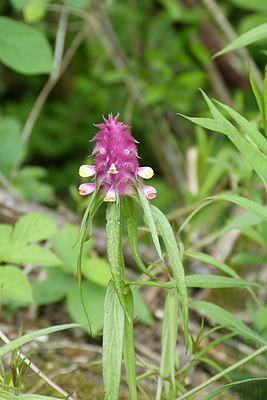Comb quail wheat
| Comb quail wheat | ||||||||||||
|---|---|---|---|---|---|---|---|---|---|---|---|---|

Comb quail wheat ( Melampyrum cristatum ) |
||||||||||||
| Systematics | ||||||||||||
|
||||||||||||
| Scientific name | ||||||||||||
| Melampyrum cristatum | ||||||||||||
| L. |
The Melampyrum ( Melampyrum cristatum ) is a species of the genus Melampyrum and thus the family Orobanchaceae (formerly Scrophulariaceae).
description
At first glance, the comb quail wheat resembles the meadow quail wheat . Its yellowish white flowers, however, are tinged with purple and stand in spikes on all sides. It is 10 cm to 50 cm tall. The leaves are 5–10 cm long and 0.3–1.2 cm wide. They are narrow to broadly lanceolate, pointed, with entire margins, only the uppermost are serrated on both sides above their base.
The bracts are seated with a broad, heart-shaped base and have a long, leafy tip. The basal leaf halves are single to double serrated, whitish, but towards the edges to yellow-green or also purple and pressed against the bases of the bracts above. The flowers are more or less steeply erect to horizontally protruding. The calyx is dorsiventral. The two anterior calyx-lobes are short, triangular, the two posterior long, linear and slightly saber-shaped curved upwards from a broad base. The corolla is 12-16 mm long, of a pale yellow base color, but mostly purple in the middle section of the tube. The corolla tube is almost twice as long as the chalice. The flowering period is between June and September.
The chromosome number of the species is 2n = 18.
Occurrence
Comb quail wheat loves lime. It inhabits dry to fresh, light oak and pine forests and their edges, light bushes and semi-arid lawns. The species occurs only rarely to absent-minded in Germany. Sociologically, the species in Central Europe can be assigned to the Geranion sanguinei association, but also to the Querco-Ulmetum association and the Quercion pubescenti-petraeae association.
Comb quail wheat occurs in the temperate zones of Eurasia.
Systematics
According to K. Marhold, the comb quail wheat ( Melampyrum cristatum L. ) u. a. the following synonyms: Melampyrum cristatum subsp. majus (Baumg.) Soó , Melampyrum cristatum subsp. ronnigeri (Poeverl.) Ronniger , Melampyrum cristatum subsp. solstitiale (Ronniger) Ronniger .
Danger
In the last few decades, a decline in stocks has been seen in Central Europe, so that the comb quail wheat is considered endangered in Germany (Red List 3).
literature
- Eckehart J. Jäger, Klaus Werner (Ed.): Excursion flora from Germany . Founded by Werner Rothmaler. 10th edited edition. tape 4 : Vascular Plants: Critical Volume . Elsevier, Spektrum Akademischer Verlag, Munich / Heidelberg 2005, ISBN 3-8274-1496-2 .
- Dimitri Hartl: “Scrophulariaceae”. In Gustav Hegi : Illustrated Flora of Central Europe . 2nd edition Volume IV, Part 1, pages 48–451. Carl Hanser Verlag Berlin 1965. (Description section)
Individual evidence
- ↑ a b Erich Oberdorfer : Plant-sociological excursion flora for Germany and neighboring areas . 8th edition, page 848. Stuttgart, Verlag Eugen Ulmer, 2001. page 848. ISBN 3-8001-3131-5
- ↑ Karol Marhold, 2011: Scrophulariaceae : Datasheet Melampyrum cristatum In: Euro + Med Plantbase - the information resource for Euro-Mediterranean plant diversity.
Web links
- Comb quail wheat. In: FloraWeb.de.
- Comb quail wheat . In: BiolFlor, the database of biological-ecological characteristics of the flora of Germany.
- Profile and distribution map for Bavaria . In: Botanical Information Hub of Bavaria .
- Melampyrum cristatum L. In: Info Flora , the national data and information center for Swiss flora . Retrieved March 14, 2016.
- Distribution in the northern hemisphere according to Hultén
- Thomas Meyer: Quail wheat data sheet with identification key and photos at Flora-de: Flora von Deutschland (old name of the website: Flowers in Swabia )
